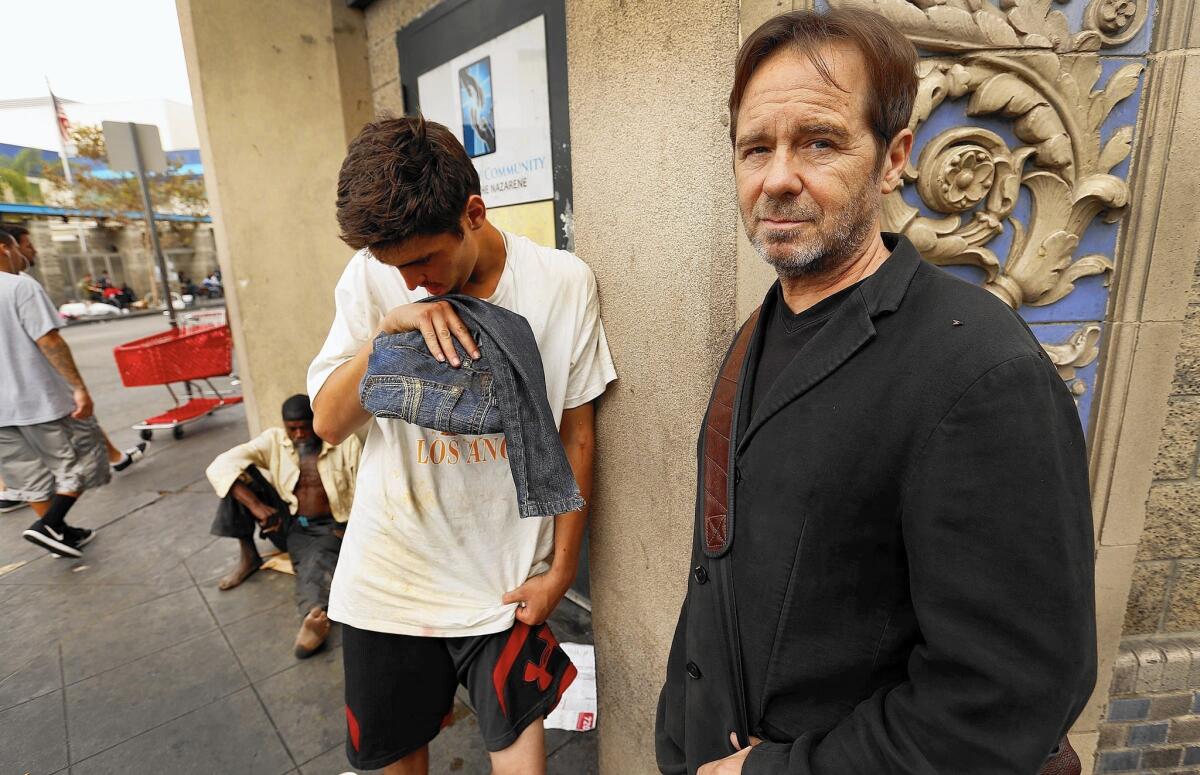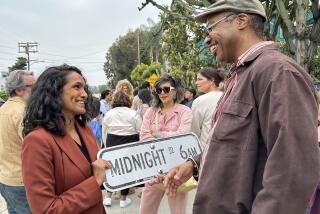Sam Slovick captures Occupy L.A.’s rage in ‘Radicalized’ documentary

Sam Slovick is in search of revolution. Anywhere. He roamed skid row the other day past tents, slumbering men and a woman with a doll who said she once worked at the White House. Dope and sweat tanged the air. Slovick, a misfit with scuffed shoes and a satchel, strolled on in no hurry, as if searching for foot soldiers amid the shopping carts of the dispossessed.
“We’re in big trouble,” said the filmmaker and former heroin addict who once ran with Andy Warhol. “Some people have an awareness that millennials and a lot of people of color don’t have a lot to lose. People on the Westside may not see it, but it’s a revolution. It’s bad and it’s going to get a lot worse.”
His documentary, “Radicalized,” opens Sept. 18 at the Arena Cinema in Hollywood. Unwieldy as its subject, the movie is a kaleidoscope of the rage and disillusionment that energized young activists in the Occupy Los Angeles protests. Marchers called for civil rights and economic parity; rallies broke out against banks, corporations, foreclosures and student loan debt. Tents crowded City Hall for eight weeks but no unifying voice emerged and much of the resistance faded after police cleared the encampment.
SIGN UP for the free Indie Focus movies newsletter >>
“I got drawn into the vortex. I had to let the kids tell their story,” said Slovick, 57, who lived in a tent, shot 3,000 hours of video and profiled anarchists who moved to a collective in Echo Park to work on political opposition. “I chose not to narrate it. I let the voices of the protesters speak for themselves. It was a predictable matrix. The omnipotence of youth. But the movement was out of focus.”
Economic uncertainty for a younger generation and racial touchstones, such as police shootings in Ferguson, Mo., and other cities, have since rekindled what one of the film’s protesters called a battle to “get back our democracy.” But sustaining a widespread populist movement — despite anxiety spreading among African Americans and through the working and middle classes — needs a galvanizing message that four years ago largely eluded the nationwide Occupy protests.
“We need,” said Slovick, heading soon to the jungles of Peru for a film about how shamanism can be an alternative cure to schizophrenia, “a confluence of anger going against the 1%.”
Slovick wears the earnestness of a boy raised in Oshkosh, Wis. Gray peeks from his beard; thin lines gather around his eyes. His voice has the hushed texture of the late Lou Reed. Growing up gay in the Midwest in the 1970s, he listened to Blue Oyster Cult in a post-hippie era of “emancipation that wasn’t homophobic.” He tripped on LSD when he was 12; dropped out of high school and left home at 16.
“My dad,” he said, “drove me to the freeway.”
“Sam’s brilliant and courageous and he has an uncanny ability to talk to the masters of the universe in their skyscrapers or the homeless on skid row or the hustlers in West Hollywood,” said Joe Donnelly, who edited Slovick’s stories at the LA Weekly. “There’s not too much he’s afraid of … he empathizes with the marginalized, for sure.”
Donnelly said “Radicalized” is at once “all out of whack and all there.” It is unbundled and scattered, unvarnished and raw, much like the man who made it.
Rough road west
Slovick tends to turn up in places with smoky windows, such as the Monte Carlo coffee shop on 5th Street, where he sat at the counter and ordered white toast and coffee. He nodded to a few disheveled faces and — with wry humor and existential asides — retraced the strange roads that led him to Los Angeles.
After leaving home and hitchhiking to the West Coast, Slovick arrived in New York in the 1980s. He discovered the art scene and hung with the likes of Warhol’s crowd and David Bowie’s future drummer Sterling Campbell. He wrote songs and sang in a group called the Pedantiks. “An art fag band,” he said. “It was the age of Madonna. We were pop.” He said he burned through days and nights on speedballs, heroin and dust.
He lived in the Chelsea neighborhood and went to the Danceteria nightclub, where he met George Haas, the doorman. They went on a date, strolling down 14th Street.
“He bought drugs from five people on the street,” said Haas, now a Buddhist meditation teacher in Los Angeles. “Pot, Valium and other things. The romantic interest for me ended there. He was ambitious, young and wanted to be a rock star. He certainly never walked away from the seamy side.”
“Lots of people went on to do other things. I went into rehab. I was a heroin addict,” said Slovick. “I woke up on the floor after an overdose and realized it had to stop.” He tried Alcoholics Anonymous, yoga and meditation. “I stopped trying to have a career. I did odd jobs. I had a monkey at some point in time and started selling Häagen-Dazs.”
He got a part in the TV series “Fame.” He quit after six episodes. He appeared in the movies “Red Dawn” and “Home for the Holidays.” And on “The Cosby Show.” “I played [Theo’s] friend,” he said. “I was still doing drugs at the time. I was physically worn out. I had hepatitis. I once shot up in an emergency room … I got sober and moved to L.A. [in 1993]. I have friends here.”
He co-founded the band Louie Says whose songs were featured on “Baywatch” and “Buffy the Vampire Slayer.” Details magazine hired him as an editorial assistant. He started writing. “I didn’t go to high school. But how hard could it be?”
He drew assignments from LA Weekly, covering topics such as street life, social issues and scenes from an LGBT bar. In 2008, he made short videos about life on skid row, including one about a boy who cataloged his restless life with a camera.
“My mother gave me a sense of being a white kid with privilege,” he said. “She gave me that lesson early on. I was privileged but no better than anybody else. So when I got to skid row — I was a junkie in New York City — I tried to understand. It wasn’t a white savior complex but I realized I could use my privilege and access to be of service. I don’t believe that at all now.”
Activist filmmaking
“Radicalized” brought him into the heart of a new, if ill-defined, movement. His passion was shared by Steven Gute, the film’s editor and producer, who once worked for Warner Bros. but grew disenchanted with the Hollywood system. “Sam’s a real visionary who wants to tell the truth,” said Gute, who worked on a “crazy three-and-half-year journey” to put the film together.
He and Slovick debated whether Slovick should narrate the film to give it more structure. They tried a few voice-overs but Gute said they detracted from the film’s authenticity. “We didn’t want to editorialize,” said Gute, adding that he and Slovick will coordinate with activist groups to screen the film internationally. “It would be much more powerful and honest for [the message] to come from the actual people.”
The film is not set for widespread theatrical distribution, but Slovick is hoping to distribute it through various platforms to activist groups at home and abroad.
Slovick lives these days in Chinatown. He finds comfort in outcasts and doesn’t hurry from broken places. “Radicalized” is an extension of the bruised and bitter side of America he has staked out for years. He stopped recently at the Midnight Mission on skid row. Faces watched TV in dim light; a few men sat waiting for haircuts near pictures of Joan Collins and Elizabeth Taylor. Slovick waved and headed outside.
A young man with scraped knuckles asked him for a dollar.
“I don’t have much,” said Slovick, pulling a few coins from his pocket. “Here.”
The man took them and disappeared into a market.
“Looks like he had a rough night,” said Slovick, walking toward a cafe as the sun lifted in the distance over the towers of the financial district.
MORE:
‘We Come as Friends’: A ride through poverty, swindles, death in South Sudan
‘Crouching Tiger’ composer Tan Dun will give L.A. Phil a martial-arts workout
Anna Muylaert tackles Brazilian child-rearing customs in ‘The Second Mother’
More to Read
Only good movies
Get the Indie Focus newsletter, Mark Olsen's weekly guide to the world of cinema.
You may occasionally receive promotional content from the Los Angeles Times.











